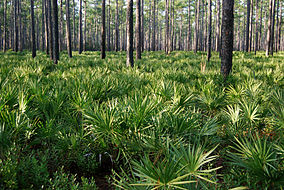Osceola National Forest: Difference between revisions
| Line 66: | Line 66: | ||
[[Category:Protected areas of Hamilton County, Florida]] |
[[Category:Protected areas of Hamilton County, Florida]] |
||
[[Category:Osceola National Forest| ]] |
[[Category:Osceola National Forest| ]] |
||
[[Category:1931 establishments in Florida]] |
|||
Revision as of 06:20, 19 February 2014
| Osceola National Forest | |
|---|---|
IUCN category VI (protected area with sustainable use of natural resources) | |
 | |
| Lua error in Module:Location_map at line 526: Unable to find the specified location map definition: "Module:Location map/data/USA relief" does not exist. | |
| Location | Florida, USA |
| Nearest city | Olustee, FL |
| Area | 190,932 acres (77,267 ha) |
| Established | July 10, 1931 |
| Governing body | U.S. Forest Service |
| www | |


Osceola National Forest is an American National Forest located in Florida.
Osceola National Forest was created by President Herbert Hoover's proclamation, on July 10, 1931. It is named in honor of the Native American Seminole warrior, Osceola.
The forest is made up of approximately 200,000 acres (810 km2) of pine flatwoods and cypress-hardwood swamps in northeastern Florida and is about 50 miles (80 km) west of Jacksonville. It is located in parts of Columbia, Baker, Bradford, and Hamilton counties.[1] The forest is headquartered in Tallahassee, as are all three National Forests in Florida, but there are local ranger district offices located in Olustee. There is one officially designated wilderness area in the forest, the 13,660 acres (55.3 km2) Big Gum Swamp Wilderness.
Geography and ecology
Within the forest is the Osceola Research Natural Area, designated a National Natural Landmark in December 1974.[2][3]
Osceola National Forest is home to many species including the American Alligator, the Florida Black Bear and the Red-cockaded Woodpecker, an endangered species.
Activities
A 28-mile (45 km) section of the Florida National Scenic Trail is included in the park grounds. Other hiking trails in the Park include: Olustee Battlefield Trail (an American Civil War battlefield), Trampled Track Trail, and Mt. Carrie Trail. There are two horseback riding trails through open pine flatwoods and near scenic bays. The park is also open to hunters and fishermen with permits.
Campsites
- Ocean Pond Campground - Ocean Pond Campground is located on the north side of Ocean Pond, a 1,760-acre (7.1 km2) natural lake. Sixty-seven campsites are available for tents, trailers, or motor homes. Ocean Pond provides a variety of recreational experiences such as fishing, boating, water skiing and camping. A beach area, boat ramp, drinking water, hot showers, and flush toilets are located in the campground.
- The Landing Group Area - Available by reservation only, this is a 50 person private group area. Recreational activities include swimming, boating, camping, and picnicking. Facilities include a sand beach, boat launch for small boats, picnic shelter, large group grill, and restrooms with showers.
- Hunt Camps - Hunt camps include Hog Pen Landing, Cobb, Wiggins, West Tower, and East Tower. These are primitive camp sites.
See also
References
- ^ Table 6 - NFS Acreage by State, Congressional District and County - United States Forest Service - September 30, 2007
- ^ Osceola Research Natural Area - National Natural Landmark
- ^ Nelson, Gil (1995). Exploring Wild North Florida. Pineapple Press Inc. p. 244. ISBN 1-56164-091-3. OCLC 32746332.
External links
- IUCN Category VI
- National Forests of Florida
- National Natural Landmarks in Florida
- Protected areas of Columbia County, Florida
- Protected areas established in 1931
- Protected areas of Baker County, Florida
- Protected areas of Bradford County, Florida
- Protected areas of Hamilton County, Florida
- Osceola National Forest
- 1931 establishments in Florida
